In our mountains, it is possible to observe many types of flowers, emblematic of the Alps. But can you recognise them on the hiking trails? We present them to you and help you to find your way around.
General information on mountain flowers
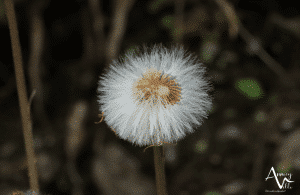 The flowers of our mountains are numerous and adapt very well to the climatic variations, sometimes important. There are several reasons for this. The vegetative reproduction method, for example, allows to counterbalance the shortened seasons.
The flowers of our mountains are numerous and adapt very well to the climatic variations, sometimes important. There are several reasons for this. The vegetative reproduction method, for example, allows to counterbalance the shortened seasons.
The bright colour of the flowers also favours pollination, which offers better UV resistance. As you may have noticed, mountain flowers are generally not very large. This allows them to reduce their exposure to the wind.
The flora varies according to the vegetation level
The flora evolves according to the altitude. For example, it will not be the same in Annecy and Grand-Bornand. The vegetation is distributed according to a succession of levels, the limits of which vary according to the exposure. In the local jargon, we refer to the Adret and Ubac to designate the sunny and shady sides of a mountain.
As for the levels, they are composed as follows:
-
The hilly stage. It extends up to an altitude of 800 metres. This is where the deciduous forests are formed.
-
The montane level. This is located between 800 and 1,500 metres and is occupied by coniferous trees, beech trees and meadows.
- The subalpine stage, from 1,500 metres to 2,200 metres. This is the upper limit of the forests. Smaller shrubs grow here.
-
The alpine zone. This stage, which extends up to 3,000 metres in altitude, gives way to alpine grasslands and rocks on which special vegetation grows.
-
The nival stage. The plants are rare, as the altitudes here are the highest.
Protection of the flora
Today, mountain flora is protected. Structures have been set up at national level, such as the National Parks, at regional level with the Regional Natural Parks and at local level with the Nature Reserves such as the Aiguilles Rouges in Chamonix. In France, it is forbidden to pick nearly 500 plants, such as the Martagon Lily or the Edelweiss.
The emblematic flowers of Haute-Savoie
Among all the flowers and plants present in Haute-Savoie and Savoie, some are more emblematic than others. We suggest you discover the main ones.
The edelweiss
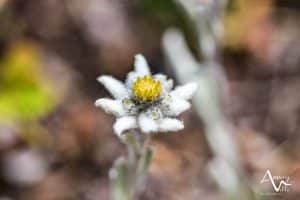
The edelweiss, leontopodium alpinum, is also known as the silver star or lion’s foot. It is probably the most emblematic flower of our mountains. Today, the edelweiss is protected in France, although it is permitted to pick up to the size of an adult’s hand.
The glacier star is not always easy to find, as it only grows between 2,000 and 3,000 metres. So you’ll have to keep your eyes open if you want to have a chance of spotting it on the hiking trails.
Blue gentian
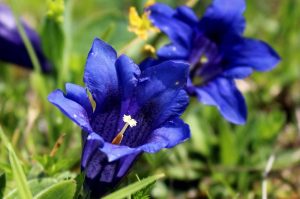 The blue gentian, gentiana lutea, is less well known than its yellow counterpart. However, it is not uncommon to come across it in our mountains, between 1,000 and 2,000 metres in altitude. It is forbidden to pick this perennial plant. The size of the blue gentian varies between 10 and 90 centimetres, depending on the variety and its location.
The blue gentian, gentiana lutea, is less well known than its yellow counterpart. However, it is not uncommon to come across it in our mountains, between 1,000 and 2,000 metres in altitude. It is forbidden to pick this perennial plant. The size of the blue gentian varies between 10 and 90 centimetres, depending on the variety and its location.
Fireweed
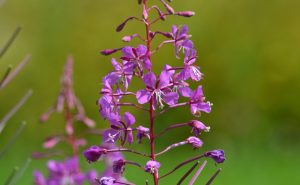
Fireweed, epilobium angustifolium. This name may not mean much to you, but it does. You will have come across it on a mountain path. These herbaceous plants have pink flowers and usually grow in groups.
The elders say that their size is a way of knowing whether or not there will be snow the following winter. Note that this wild flower is edible.
Mountain knapweed
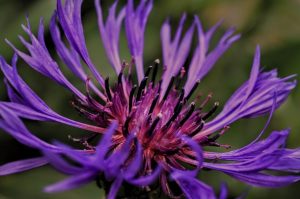
Mountain knapweed, centaurea montana, is a perennial plant that flowers between April and August in our mountains of Haute-Savoie. The flowers can be of various colours, from white to yellow to purple and pink. You will find it in the sub-alpine region, in sunny areas.
Cotton grass
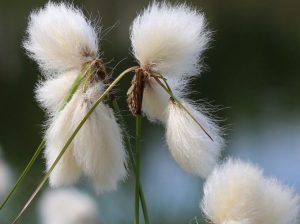
Cotton grass, eriophorum angustifolium, is also known as downy rush. It can be seen in late summer and early autumn in the vicinity of mountain lakes and marshes and helps to strengthen the banks naturally.
When it matures, it is covered with a kind of cottony down. Cotton grass is particularly hardy and cold-resistant. It needs sun and nutrient-rich soil to live.
Venus hoof
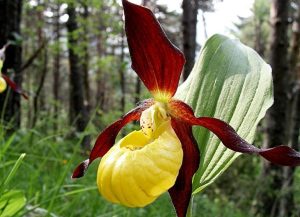
The Venus hoof, paphiopedilum, is a species of orchid with evergreen foliage. Today, it is possible to find it in certain mountainous areas such as the Bauges or the Aravis, although this remains rare.
The Venus hoof is a protected plant that is characterised by its bright yellow hoof-shaped labellum. Its flowering period takes place over one month, between the end of May and the end of June. It thrives in meadows or the most open forests.
Flowers and medicinal plants present in Haute-Savoie
Flowers are often used for self-medication. They have medicinal properties, which are specific to each plant. Here are some examples.
Arnica
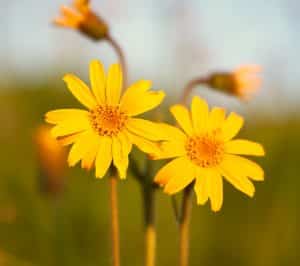
Arnica, arnica montana, is a flower found in alpine meadows. You will normally see it without difficulty during the summer season.
Arnica is used in the preparation of ointments to treat various minor injuries. It can also be taken in the form of homeopathic granules.
Our tip: use arnica as a shower gel after a sports session. Recovery will only be improved and faster.
Yellow gentian
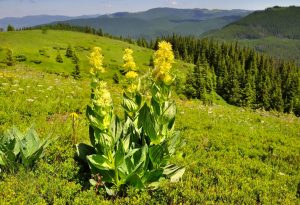
Yellow gentian, gentiana lutea, is not only used to make liqueur. It also has medicinal properties, particularly for digestion, and helps to fight stomach pains. In case of infection, it has a febrifuge action.
The yellow gentian is generally found between 800 and 1,500 metres above sea level. Its stem can reach up to 1.5 metres in height. It flowers between June and July.
Violet
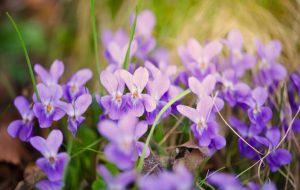
The violet, viola cenisia, can be distinguished from the alpine pansy by the arrangement of its petals. This small, bushy plant is known for its medicinal properties. It is an expectorant and calms coughs. It is best consumed as an infusion.
Violet also calms stress and is effective against indigestion. Some people even use it in the form of a hot poultice to heal small wounds or cracks more quickly.
Purple foxglove
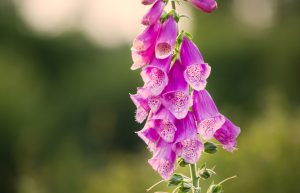
The foxglove, digitalis purpurea, is also called wolf’s tail. It can be found in the forest, in the shade.
The foxglove is known to be toxic and should therefore not be eaten like blueberries. However, it can also be used for its medicinal properties. It contains substances in its leaves that are used to regulate heart function.
Which mountain flowers for the kitchen?
Some plants and flowers found in the mountains of Savoie and Haute-Savoie can be used in cooking. It is not uncommon for restaurant owners to use them in their dishes. Focus on the best known.
Genepi
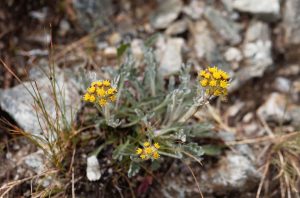
The genepi, artemisia absinthium, actually comprises four subspecies. Although it is often used to make liqueur, genepi can also be used to flavour cheeses, sausages or even beer.
Extra info: the picking of génépi is regulated and must be limited to so-called family picking. So don’t forget to find out about it before you go in search of this plant. And if you decide to let yourself be tempted, be careful not to tear up the whole plant.
Bilberries
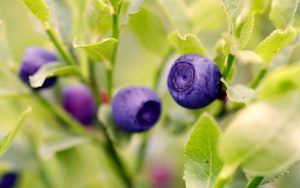
Bilberries, vaccinium myrtillus, are the source of the wild blueberries, which are very popular in cooking. Depending on the exposure to the sun and the altitude, the harvest takes place between July and September.
Bilberries have many virtues. They are anti-inflammatory and rich in vitamins. In the kitchen, you can of course make good pies, but also opt for jam or gazpacho made from red fruit.
Our tip: We recommend picking the blueberries with a special comb. This way, you will spend less time on one plane.
Bear’s garlic
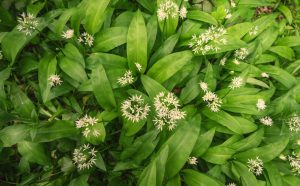
Bear’s garlic, allium ursinum, is a plant found in cool, damp undergrowth. It is possible to find it around Annecy, without having to go too far.
According to legend, bears used this garlic to purge themselves at the end of winter. For our part, we have been using it since the Neolithic period. In addition to its high vitamin C content, bear garlic is often used in cooking. We find it in cheese, soups, but also in the form of pesto.
Juniper berries
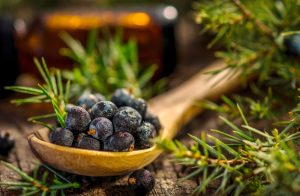 Juniper, juniperus communis, produces small, tasty berries. They are generally used as a condiment in dishes. They also have digestive and antiseptic properties. Juniper berries can be picked all year round.
Juniper, juniperus communis, produces small, tasty berries. They are generally used as a condiment in dishes. They also have digestive and antiseptic properties. Juniper berries can be picked all year round.
Our tip: to simplify the harvesting process, take a cloth with you. Place it under the branch and shake it. The berries will fall directly into it.
Rosehips
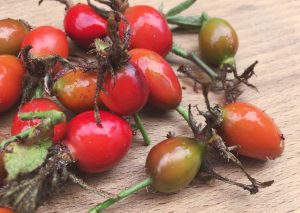
The rose hip, rosa canina, is known by several names: rose hip or even “scraper” in the local jargon. Very present up to an altitude of 1,700 metres, rose hip is harvested in winter.
Very rich in vitamin C, the berries can be consumed in the form of tea, jam or even sauces.
Our tip: whether you eat the berry cooked or raw, don’t forget to remove the black head at the end.
Poisonous plants and shrubs for our animals
You should also know that some plants and shrubs in our mountains are toxic to animals, such as dogs and horses. Here are some of them.
Eagle fern
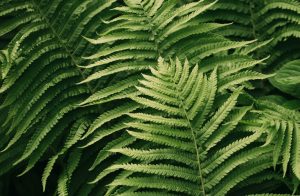
The eagle fern, pteridium aquilinum, is present in many forests of Haute-Savoie and Savoie. You can see it in the Semnoz or even in the Aravis.
It is the rhizomes that are the most toxic, especially for horses. The consumption of the eagle fern can become fatal from 80 grams. It causes severe diarrhoea, as well as colic and congestion of the kidneys or lungs.
Belladonna
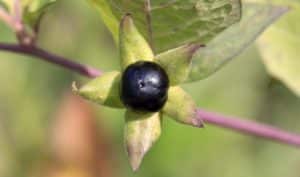
Belladonna, atropa belladonna, is a herbaceous perennial plant with stems up to 1.5 metres high.
The flower is toxic and paralyses the nervous system, causing the heart to beat faster and the pupils to dilate. The berries are the most toxic part of belladonna. You or your pets should not eat them.
Colchicum
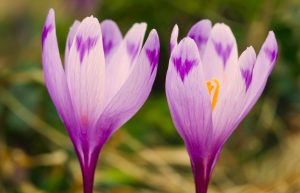
The autumn colchicum, colchicum autumnale, contains colchine. This substance can be compared to arsenic and causes respiratory paralysis. Animals are particularly sensitive to it, such as horses. A poisoned foal usually has only 48 hours to live. It is therefore best to be wary of it.
Rhododendron
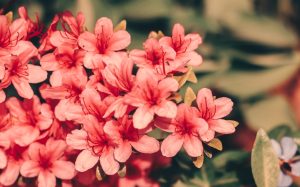
Rhododendron, better known as rhodo, is toxic to animals.
In dogs, one or two leaves are enough to cause colic or violent vomiting. In large doses, Rhododendron can cause paralysis or seizures.
Is picking wild plants risky?
Collecting wild plants is not without risk, especially if you plan to eat them afterwards. Certain precautionary principles can therefore be applied:
-
Like mushrooms, do not pick flowers if you are not sure of their origin.
- Soak flowers in vinegar for at least 15 minutes.
- Cook plants and flowers to avoid any risk of contamination.
As flowers grow in natural environments, it is not impossible that they may at some point come into contact with wild or uninfected animals.
Fox disease
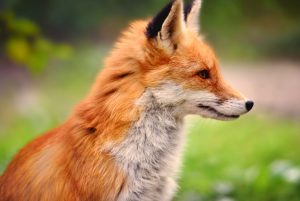 Fox disease, echinococcosis, is one of the most serious diseases that can be transmitted to humans. This parasitic disease can be transmitted by foxes, wolves, but also dogs that have eaten an infected rodent.
Fox disease, echinococcosis, is one of the most serious diseases that can be transmitted to humans. This parasitic disease can be transmitted by foxes, wolves, but also dogs that have eaten an infected rodent.
Fox disease can be fatal and on average 30 cases are reported every year in France. Haute-Savoie is particularly concerned by this disease. So do not eat the flowers collected during your hikes without having put them in vinegar.
Liver fluke
Another risk when picking flowers is liver fluke. This disease is particularly common in cattle and sheep. Transmitted to humans, it can cause cirrhosis of the liver. In order to avoid contamination, we therefore recommend that you do not eat flowers or plants that have been collected near pastures.
















